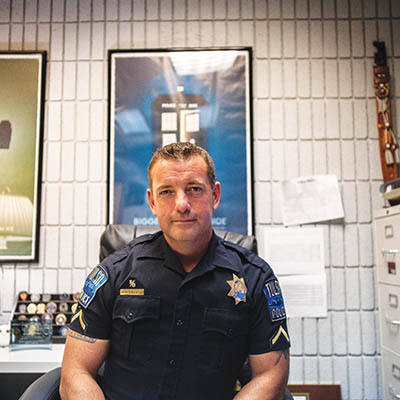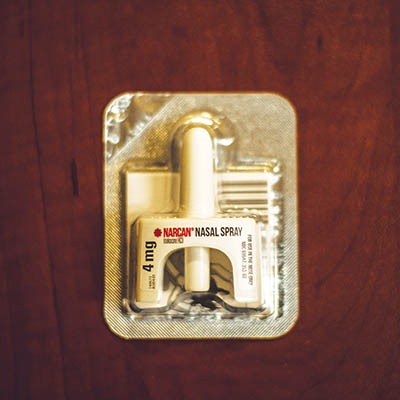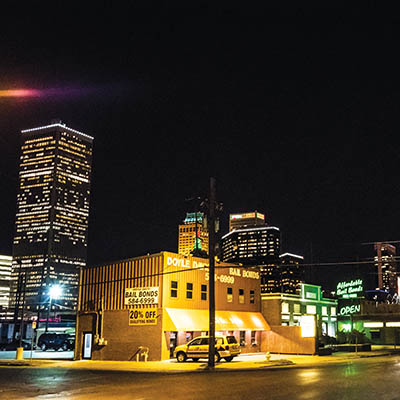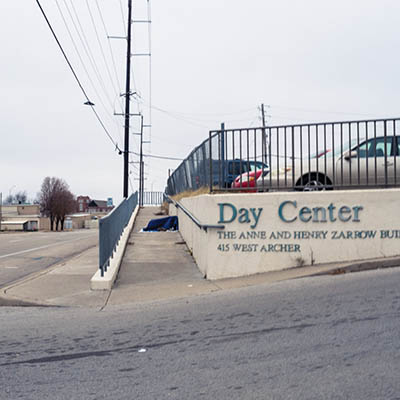The Tulsa triangle
Mental health, homelessness, and the opioid crisis form a dangerous trio
Photos by Joseph Rushmore
Tulsa has a corridor of problems few people talk about, a narrow triangle ringed with poverty, mental health issues, and substance abuse. It’s an actual physical space. The intersection at Archer Street and Denver Avenue downtown marks one edge. Every day around dusk, scores of homeless men, women, and children walk from the Tulsa Day Center, a shelter just off Archer, and head north. They pass the Family & Children’s Services Center and The Salvation Army on the corner. There’s a bus stop shaded by short red pines under which people sleep. On the west side of the street they pass the David L. Moss Criminal Justice Center, and on the east they pass a collection of gaudy bail bondsmen signs and an industrial dairy plant.
The neighborhood seems bleak at times, but every day some of these people get help from local non-
profits, religious groups, and public organizations working downtown. Sadly, and for many reasons, some don’t find help at all. You see them in heavy coats year-round, hoarding backpacks under I-244, or panhandling outside bars in the Brady District. They are tangible evidence that the social safety net has cracks, that this town has a revolving-door cycle of poverty and homelessness.
Over the past few years, these issues have been compounded by the introduction of an inexpensive painkiller known as Fentanyl into Oklahoma’s drug economy. The opioid crisis, which has devastated so many communities nationally, has taken Tulsa’s complex social problems and magnified them.
Anthony First, a decorated 15-year veteran of the Tulsa Police Department, presently serves as the main law enforcement instructor for the department of mental health and substance abuse services in the state. He trains police officers across Oklahoma in the use of Narcan, an opiate-specific anti-overdose agent credited with saving thousands of lives. Officer First has watched the opioid crisis evolve here.
 “EMSA has been hammered with overdose calls,” said First. “It’s been that way for some time. Unfortunately, we now have a general acceptance that this is the new normal. It’s only been in the last two years that Fentanyl became so prominent. In times past, if you found white powder it was usually cocaine. It’s not that way anymore. Now it’s usually Fentanyl.”
“EMSA has been hammered with overdose calls,” said First. “It’s been that way for some time. Unfortunately, we now have a general acceptance that this is the new normal. It’s only been in the last two years that Fentanyl became so prominent. In times past, if you found white powder it was usually cocaine. It’s not that way anymore. Now it’s usually Fentanyl.”
According to the CDC, Oklahoma was in the top five states in the nation in 2016 for pill overprescription. Early data suggests the current digital pill tracking system may be starting to solve this problem, but doctor overprescription only represents a fraction of the Fentanyl and opioid crisis here. Trucks loaded with pills cross into the state from Texas and Missouri every day, and law enforcement believes the source of these opioids is overseas.
“It’s shipped on the same routes that every other drug comes in,” said First. “The same routes methamphetamine and marijuana and ecstasy take. It’s the same business network. It’s not necessarily being diverted from legitimate prescription companies. It’s that China can make it, and they can smuggle it into the U.S. With any country, if there’s enough money involved, mechanisms can be created. As long as there is a customer base and there’s money, they will find a way. If you think about the distribution system for any drug, whether it’s cocaine or methamphetamine, it’s more organized than Walmart. The smaller agencies I teach at are right on major highways. On I-40 or I-35, many of their car stops result in hundreds or thousands of pills of Fentanyl. It’s just out there—everywhere. It’s not hard to get.”
The prevalence of these pills has altered the appearance of addiction all over Oklahoma. Rural counties have seen upticks in crime and violence. The image of melancholy teenagers experimenting no longer holds. Police statistics suggest that the most common demographic of heroin addicts in Tulsa County today is white moms from the suburbs, ages 24 to 35. These same women often graduate to Fentanyl.
“Pretty much everywhere, it always starts out with pills and, usually, no intent to become addicted,” said First. “People get in an accident, they have back injuries—that kind of thing. At first they have a prescription, but now pills are getting harder to find. We have a database system in Oklahoma that requires doctors to track how many scheduled medications are given to an individual patient. When patients find themselves unable to get pills, they go over to things like heroin. Heroin typically, though, is not that powerful. It’s very addictive, but on average it’s 15 to 35 percent pure. Then enters Fentanyl, which has become more prevalent than cocaine and which is 100 percent pure. If you can get ahold of Fentanyl, why bother with heroin?”
 Fentanyl and heroin have changed the jobs of Oklahoma’s emergency responders. EMSA paramedics used Narcan to revive patients from overdose a total of 970 times in 2016. This is the largest number of uses in the state's history. Police started carrying Narcan recently, in response to chaotic situations out in the field.
Fentanyl and heroin have changed the jobs of Oklahoma’s emergency responders. EMSA paramedics used Narcan to revive patients from overdose a total of 970 times in 2016. This is the largest number of uses in the state's history. Police started carrying Narcan recently, in response to chaotic situations out in the field.
“Our officers are being flagged down,” said First. “We had an officer on a traffic stop and a car pulled up behind him. The driver jumped out and said, ‘Hey, we just bought heroin, and my friend’s not breathing!’ So the officer got him Narcan and brought him back.
“Several times, potential suspects have tried to eat their drugs before they saw us. They would see us walking or driving up and eat everything they had on them. They’d pass out right there in front of us. In fact our very first use of Narcan was that. It was in the area of South 61st Street and Peoria Avenue, and the officers were about to check somebody who was suspicious. He swallowed a bunch of pills as they were walking up and passed out as the officers were talking to him. We’re very happy people are feeling more free to flag us down. Had that driver I mentioned not felt like they could stop and talk to us and not worry necessarily about arrest, the passenger probably would've died.”
The scale of the national opioid crisis has only recently started to become clear—and Oklahoma’s public policy isn’t prepared for these new realities. Critical services are strained statewide, and the 215 million dollar budget shortfall next year only increases the strain. Fewer dollars means fewer services for people in need. Fewer drug rehab clinics, fewer addiction treatment specialists, social workers, and state grant dollars to support an already beleaguered mental health and addiction system.
Michael Brose, CEO of the Mental Health Association Oklahoma (MHAOK), put this problem in its broader context.
“If that 215 million dollar hole is filled, that just takes us back to breaking even, underfunded,” he said, then went on to explain how funding for mental health care in Oklahoma has not kept pace with inflation.
“If the hole’s not filled, the Department of Mental Health has to pass the cuts along … And what happens if those people can’t get services? It’s going to put an added burden on the emergency rooms, first responders, police, fire, ambulance; you put everybody at risk. And then you fall back to reinforcing and expanding the largest mental health institutions in the state of Oklahoma—our jails and our prisons.”
 This has local police genuinely concerned. Tulsa’s resources are insufficient now. There is only one publicly-funded mental health and addiction facility in the whole city, Tulsa Center for Behavioral Health (TCBH). But the entire facility only has 56 beds. There’s also only one publicly-funded drug rehabilitation center in Tulsa. It’s called 12 & 12, Inc., and the waiting list to get in averages between 4 and 6 weeks. Private facilities like Laureate Psychiatric Clinic and Hospital and Shadow Mountain Behavioral Health System can cost between $15,000 and $30,000 a year. For the homeless or working-class families struggling with opioid addiction, those prices and wait times are infeasible. Police fear that successful programs, like Family & Children’s Services’ Community Outreach Psychiatric Emergency Services (COPES) and 12 & 12, Inc. could be on the chopping block for budget cuts next year.
This has local police genuinely concerned. Tulsa’s resources are insufficient now. There is only one publicly-funded mental health and addiction facility in the whole city, Tulsa Center for Behavioral Health (TCBH). But the entire facility only has 56 beds. There’s also only one publicly-funded drug rehabilitation center in Tulsa. It’s called 12 & 12, Inc., and the waiting list to get in averages between 4 and 6 weeks. Private facilities like Laureate Psychiatric Clinic and Hospital and Shadow Mountain Behavioral Health System can cost between $15,000 and $30,000 a year. For the homeless or working-class families struggling with opioid addiction, those prices and wait times are infeasible. Police fear that successful programs, like Family & Children’s Services’ Community Outreach Psychiatric Emergency Services (COPES) and 12 & 12, Inc. could be on the chopping block for budget cuts next year.
COPES is a mobile psychiatric crisis service in Tulsa that also manages the suicide prevention hotline. They average between 1,200 and 1,300 calls a week and often follow up with a suicidal or in-crisis client for weeks. This is the type of relationship-oriented community work that produces results. COPES Clinical Supervisor Laura James describes their work as a mixture of counseling, mental health consulting, and connecting patients to services.
“Ninety-nine percent of the time on police calls, we’re able to keep them from going to jail,” said James. “So we help divert from jail, and our goal is to always stabilize them in the least restrictive means. So, keeping them out of the hospital. We’re able to do that about seventy percent of the time. We also work really closely with the police department. Not just the Tulsa Police Department, but all of the Tulsa county police departments. So, Skiatook, Owasso, Glenpool, Sand Springs—all those little areas.”
Police feel ill-equipped for these tasks. The opioid crisis and the lack of addiction resources in Tulsa intensifies this. Rachel Diacon, another clinical supervisor at COPES, put it more bluntly.
“We need more rehab treatment locations,” she said. “A person on a waitlist in Tulsa for treatment often has no choice but to keep using heroin or pills, and there’s usually such a brief window of time when people are ready to quit. When people want to detox and to get help, we want places for them to go. We want to stabilize people, and we want people to be able to stay home and be safe, but we don’t always have the resources to do that.
“You can’t quit cold turkey. It can be lethal ... Heroin and opioids are among the most dangerous to detox off of. With meth you’ll get sick, but you can detox off of it and be ok. With heroin and opioids, you might not be ok.”
No problem exists in a vacuum. The opioid crisis and homelessness in Tulsa are connected. Rev. Steve Whitaker, director of the John 3:16 Mission, says that the homeless population in Tulsa is growing and that opiates are to blame.
“We’ve been over our limit for a while, but the numbers are up substantially,” he said. “Those numbers have been creeping up the last 24 to 36 months. Opiates are now the new normal. It’s insidious. I think it would be unfair at this point to single out the homeless. Although that’s the context we’re talking about today. It should be said that you could be talking about a high-end attorney that’s spending $100,000 a year on opiates, or you could be talking about a doctor that’s fallen into addiction.
 “We’re seeing high-performing, white-collar people find themselves homeless on the streets in Tulsa, Oklahoma, because opiates have taken them. We can and we must do better with them and for them.”
“We’re seeing high-performing, white-collar people find themselves homeless on the streets in Tulsa, Oklahoma, because opiates have taken them. We can and we must do better with them and for them.”
John 3:16’s facility is about 10 percent over capacity right now. This normally doesn’t happen until the hardest part of winter, but now there are so many people at the site that some are sleeping on benches in the lobby.
The Tulsa triangle is growing, and law enforcement is looking elsewhere for solutions.
“We can’t incarcerate our way out of this problem,” First said. “My officers out there agree with that. It doesn’t do us any good to lock someone up for a problem like that when their lives are endangered. It certainly doesn’t help the patient.”
Though the crisis is staggering, people who have dedicated themselves to the mission of battling addiction and serving vulnerable populations in Tulsa haven’t given up.
“I’m hopeful about it,” said James. “I know that there’s a lot of different ideas people get about those who have mental illness and people who are struggling, but we get to see those people on their worst days, and it’s really amazing how resilient people are. Whatever they’ve been faced with through the years in their childhood or in their young adulthood, it is amazing to me. That’s one thing that this job has taught me: People have hope and resiliency if they can get a hand up and get that support from the community that they need.”


.jpg)
.jpg)
